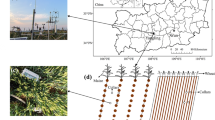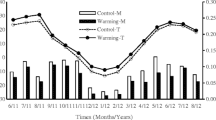Abstract
Based on continuous three-year measurements (from 2004 to 2007) of eddy covariance and related environmental factors, environmental controls on variation in soil respiration (R s) during non-growing season were explored in a maize agroecosystem in Northeast China. Our results indicated that during non-growing seasons, daily R s was 1.08–4.08 g CO2 m−2 d−1, and the lowest occurred in late November. The average R s of non-growing season was 456.06 ± 20.01 g CO2 m−2, accounting for 11% of the gross primary production (GPP) of the growing season. Additionally, at monthly scale, the lowest value of R s appeared in January or February. From the beginning to the end of non-growing season, daily R s tended to decrease first, and then increase to the highest. There was a significant quadratic curve relationship between R s and soil temperature at 10 cm depth when soil temperature was more than 0°C (P<0.001), with the explaining ratio of 38%–70%. When soil water content was more than 0.1 m3 m−3, soil moisture at 10 cm depth was significantly parabolically correlated with R s (P<0.001), explaining the rate of 18%–60%. Based on all the data of soil temperature of more than 0°C, a better model for R s was established by coupling soil temperature and moisture, which could explain the rate of up to 53%–79%. Meanwhile, the standard error of regression estimation between the values of prediction and observation for R s could reach 2.7%–11.8%. R s in non-growing season can account for 22.4% of R s in growing season, indicating that it plays a critical role in assessing the carbon budget in maize agroecosystem, Northeast China.
Similar content being viewed by others
References
Wood S, Sebastian K, Scherr S J. Pilot Analysis of Global Ecosystems: Agroecosystems. Washington DC: IFPRI, WRI, 2000. 2–36
Suyker A E, Verma S B, Burba G G, et al. Gross primary production and ecosystem respiration of irrigated maize and irrigated soybean during a growing season. Agric For Meteorol, 2005, 131: 180–190
Verma S B, Dobermann A, Cassman K G, et al. Annual carbon dioxide exchange in irrigated and rained maize-based agroecosystems. Agric For Meteorol, 2005, 131: 77–96
Suyker A E, Verma S B, Burba G G, et al. Growing season carbon dioxide exchange in irrigated and rainfed maize. Agric For Meteorol, 2004, 124: 1–13
Hollinger S E, Bernacchi C J, Meyers T P. Carbon budget of mature no-till ecosystem in North Central Region of the United States. Agric For Meteorol, 2005, 130: 59–69
Law B E, Falge E, Gu L, et al. Environmental controls over carbon dioxide and water vapor exchange of terrestrial vegetation. Agric For Meteorol, 2002, 113: 97–120
Li J, Yu Q, Sun X M, et al. Carbon exchange and its environmental regulation mechanism in North Plain ecosystem in the North China (in Chinese). Sci China Ser D-Earth Sci, 2006, 36(SuppI): 210–223
Ren X E, Wang Q X, Tong C L, et al. Estimation of soil respiration in a paddy ecosystem in the subtropical region of China. Chinese Sci Bull, 2007, 52: 2722–2730
West T O, Marland G. Net carbon flux from agricultural ecosystems: Methodology for full cycle analyses. Environ Pollut, 2002, 116: 439–444
Robertson G P, Paul E A, Harwood R R. Greenhouse gases in intensive agriculture: contributions of individual gases to the radiative forcing of the atmosphere. Science, 2000, 289: 1922–1925
Zimov S A, Davidov S P, Voropaev Y V, et al. Siberian CO2 efflux in winter as a CO2 source and cause of seasonality in atmospheric CO2. Clim Change, 1996, 33: 111–120
Oechel W C, Hastings S J, Vourlitis G. Recent change of arctic tundra ecosystems from a net carbon dioxide sink to source. Nature, 1993, 361: 520–523
Hobbie S E, Chapin III F S. Winter regulation of tundra litter carbon and nitrogen dynamics. Biogeochemistry, 1996, 35: 327–338
National Bureau of Statistics of China. China Statistical Yearbook (in Chinese). Beijing: China Statistics Press, 2007. 324
Han G X, Zhou G S, Xu Z Z, et al. Biotic and abiotic factors controlling the spatial and temporal variation of soil respiration in an agricultural ecosystem. Soil Biol Biochem, 2007, 39: 418–425
Falge E, Baldocchi D, Olson R, et al. Gap filling strategies for defensible annual sums of net ecosystem exchange. Agric For Meteorol, 2001, 107: 43–69
Han G X. Dynamics of soil respiration and its simulation in a maize Agro-ecosystem. Dissertation for the Doctoral Degree (in Chinese). Beijing: Institute of Botany, Chinese Academy of Sciences, 2007. 1–3
Skogland T, Lomeland S, Goksøyr J. Respiratory burst after freezing and thawing of soil: Experiments with soil bacteria. Soil Biol Biochem, 1988, 20: 851–856
Coxson D S, Parkinson D. Winter respiratory activity in aspen woodland forest floor litter and soils. Soil Biol Biochem, 1987, 19: 49–59
Clein J S, Schimel J P. Microbial activity of tundra and taiga soils at sub-zero temperatures. Soil Biol Biochem, 1995, 27: 1231–1234
Li Y J. Dynamics of carbon, water and heat fluxes and their environmental controls in a maize agroecosystem (in Chinese). Dissertation for the Doctoral Degree. Beijing: Institute of Botany, Chinese Academy of Sciences, 2008. 78–79
Elberling B, Brandt K K. Uncoupling of microbial CO2 production and release in frozen soil and its implications for field studies of arctic C cycling. Soil Biol Biochem, 2003, 35: 263–272
Schimel J P, Clein J S. Microbial response to freeze-thaw cycles in tundra and taiga soils. Soil Biol Biochem, 1996, 28: 1061–1066
Conant R T, Klopatek J M, Klopatek C C. Environment factors controlling soil respiration in three semiarid ecosystems. Soil Sci Soc Am J, 2000, 64: 383–390
Mielnick P C, Dugas W A. Soil CO2 flux in a tallgrass prairie. Soil Biol Biochem, 2000, 32: 221–228
Dilustro J J, Collins B, Duncan L, et al. Moisture and soil texture effects on soil CO2 efflux components in southeastern mixed pine forests. Forest Ecol Manag, 2005, 204: 85–95
Boone R D, Nadelhoffer K J, Canary J D, et al. Roots exert a strong influence on the temperature sensitivity of soil respiration. Nature, 1998, 396: 570–572
Epron D, le Dantec V, Dufrene E, et al. Seasonal dynamics of soil carbon dioxide efflux and simulated rhizosphere respiration in a beech forest. Tree Physiol, 2001, 21: 145–152
van’t Hoff J H. Etudes de Dynamique Chimique (Studies of Chemical Dynamics). Amsterdam: Frederik Muller and Co, 1885. 1–25
Arrthenius S. The effect of constant influences upon physiological relationships. Scand Arch Physiol, 1989, 8: 367–415
Dong Y S, Qi Y C, Liu J Y, et al. Variation characteristics of soil respiration fluxes in four types of grassland communities under different precipitation intensity. Chinese Sci Bull, 2005, 50: 583–591
Luo Y Q, Zhou X H. Soil Respiration and the Environment. San Diego: Elsevier Inc, 2006. 215–230
Davidson E A, Belk E, Boone R D. Soil water content and temperature as independent or confound factors controlling soil respiration in a temperature mixed hardwood forest. Glob Change Biol, 1998, 4: 217–227
Schlentner R E, Van Cleve K. Relationships between CO2 evolution from soil, substrate temperature, and substrate moisture in four mature forest types in interior Alaska. Can J Forest Res, 1985, 15: 97–106
Grogan P, Chapin III F S. Arctic soil respiration: Effects of climate and vegetation depend on season. Ecosystems, 1999, 2: 451–459
Gao F, Wang B S. A study on global warming and the temperature changes in the northeast region (in Chinese). Mar Forecasts, 2008, 25: 25–30
Wang Q F. Soil respiration of Larix Gmelinii forest transplanted from a latitudinal transect (in Chinese). Dissertation for the Master Degree. Harbin: Northeast Forestry University, 2007. 12–13
Hobbie S E, Schimel J P, Trumbore S E, et al. Controls over carbon storage and turnover in high-latitude soils. Glob Change Biol, 2000, 6: 196–210
Author information
Authors and Affiliations
Corresponding author
About this article
Cite this article
Li, R., Zhou, G. & Wang, Y. Responses of soil respiration in non-growing seasons to environmental factors in a maize agroecosystem, Northeast China. Chin. Sci. Bull. 55, 2723–2730 (2010). https://doi.org/10.1007/s11434-010-3181-9
Received:
Accepted:
Published:
Issue Date:
DOI: https://doi.org/10.1007/s11434-010-3181-9




